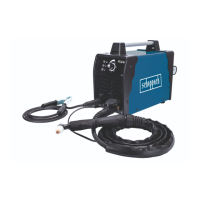www.scheppach.com / service@scheppach.com / +(49)-08223-4002-99 / +(49)-08223-4002-58
22
|
GB
A powerful spark occurs between the electrode
the spark heats up the gas until it has reached the
plasma condition. This reaction causes a current
from the controlled plasma with a temperature of
17.000 ºC or more that moves at speed of 6.096
m/sec and the metal transforms into steam and
molten discharge. The plasma itself conducts elec-
trical current. The working circuit that allows the
arc to occur remains as long as current is supplied
to the electrode and the plasma remains in contact
with the metal to be processed. The cutting nozzle
has a range of further channels. These channels
-
Please note!
This machine is only designed to use compressed air
as “gas”.
Installation environment
-
power-on time reduces and it can result in overheat-
ing. Additional protection can be required for this pur-
pose:
• The device must be free-standing with a distance
of at least 0.5 m all around.
• Ventilation slots must not be blocked or covered.
• The device must not be used a storage place and
tools or other items must not be placed on the de-
vice. It must be operated in a dry and well ventilat-
ed working environment.
Remaining hazards
The machine has been built using modern technolo-
gy in accordance with recognized safety rules. Some
remaining hazards, however, may still exist.
•
connection leads are used.
• Even when all safety measures are taken, some
remaining hazards which are not yet evident may
still be present.
• Remaining hazards can be minimized by following
the safety instructions as well as the instructions in
the chapter Authorized use and in the entire oper-
ating manual.
• Health hazard due to electrical power, with the use
of improper electrical connection cables.
• -
chine prior to any operations.
• Avoid accidental starts of the machine: Do not
press the start button while inserting the plug into
the socket.
• Use the tools recommended in this manual to ob-
tain the best results from your machine.
• Warn of the danger to the eyes by hanging up a
workplaces must be shielded so that the persons
in the vicinity are protected. Unauthorised persons
must be kept away from cutting work.
• -
places should neither be bright coloured or shiny.
Windows up to head height must be protected to
them, e.g. by using suitable paint.
• According to standard IEC 60974-10, it has to do
with a plasma cutter with class A electromagnet-
ic compatibility. Thus, it meets the appropriate re-
quirements in the industrial and residential area. In
residential areas, it can be connected to the pub-
lic low-voltage supply network. Even if the plasma
cutter complies with the emission level as per the
standard, the plasma cutter can still result in elec-
tromagnetic disturbances in sensitive systems and
devices. The operator is responsible for malfunc-
tions that occur through the arc while plasma cut-
ting and must take suitable protective measures. In
doing so, the operator must consider the following:
• Power cables, control, signal and telecommuni-
cation lines
• Computer and other microprocessor controlled
devices.
• Television, radio and other playback devices
• Electronic and electrical safety equipment
• Persons with cardiac pacemakers or hearing
aids
• Measurement and calibration devices
• Noise immunity of other devices in the vicinity
• The time of day at which the cutting work is per-
formed.
-
• The plasma cutter must be regularly maintained
and kept in a good condition
• Cutting cables should be completely unwound
• Devices and systems at risk of interference ra-
diation must be removed from the cutting area if
possible, or shielded.
General plasma explanations
• Plasma cutters are operated by pushing pressur-
ised gas, e.g. air, through a small pipe. In the cen-
tre of the pipe, there is a negatively charged elec-
trode that is directly above the nozzle. The vortex
ring causes the plasma to rotate quickly. If you sup-
ply the negative electrode with current and make
the tip of the nozzle touch the metal, this connec-
tion creates a closed, electrical circuit.

